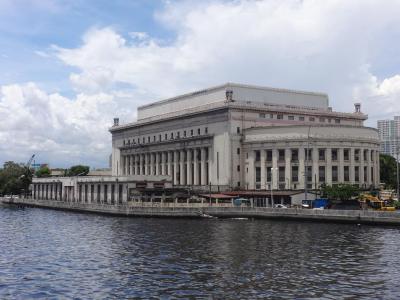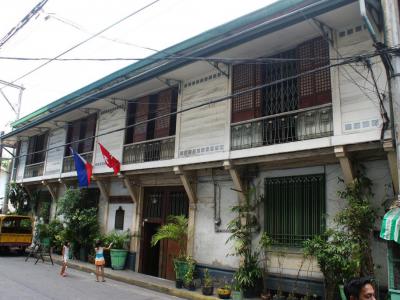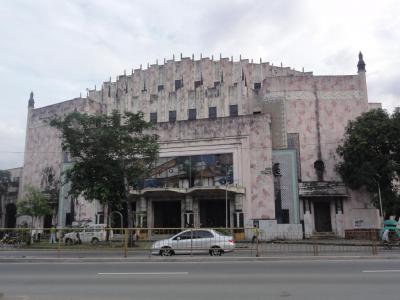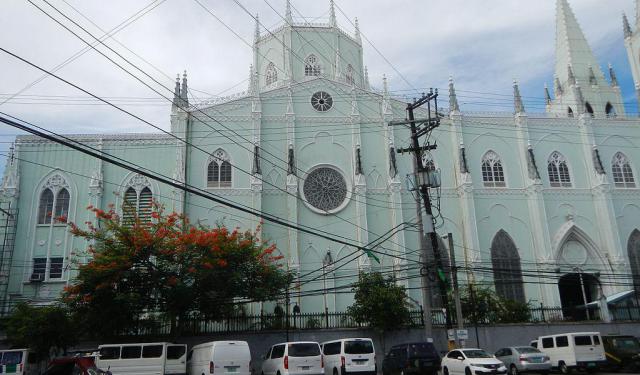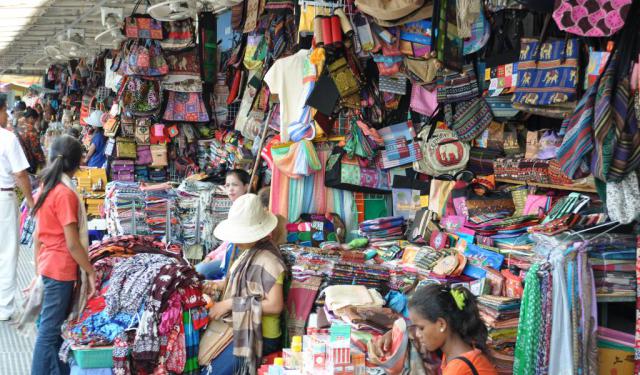
Historical Buildings Walking Tour (Self Guided), Manila
Manila’s long history results from its situation as a natural port in a huge bay. With the Spanish conquest of the Philippines in the 16th century, it became united, along with Mexico City and Madrid, into the first truly globalised trade system. Intramuros, Manila’s old walled Spanish town, stood for 350 years before World War II came, and still houses many of the historic buildings.
For a quick – but very engaging – tour of the city’s historic buildings, start at the Jones Bridge near Intramuros and look for the beautiful Central Post Office Building – an American-era landmark that lords over the Pasig River. Designed by famous Filipino architect Juan Arellano, it was built as a modern colonial architecture, an example of a perfect neo-classical monument. Arellano also designed the recently renovated Manila Metropolitan Theater, fittingly marking the tour’s end.
In between these landmarks, you will also get to see the iconic El Hogar Filipino building (designed in the Beaux-Arts/Neo-classical/Renaissance styles of architecture), and the nearby Calvo Building – another Beaux-Arts masterpiece which houses a treasure trove of pre-WWII photos and memorabilia on the 2nd floor.
Other highlights include the beautiful Bahay Nakpil-Bautista ancestral home, built in 1914. As well as an insight into the grandeur of pre-war Manila, the museum provides a history of the Ilustrados – the Filipino educated class during the Spanish colonial period in the late 19th century, and Katipunan – the anti–Spanish revolutionist movement.
If you’re interested in delving deeper in the city's past and colonial architecture, take this self-guided tour to see some of Manila’s outstanding historical landmarks!
For a quick – but very engaging – tour of the city’s historic buildings, start at the Jones Bridge near Intramuros and look for the beautiful Central Post Office Building – an American-era landmark that lords over the Pasig River. Designed by famous Filipino architect Juan Arellano, it was built as a modern colonial architecture, an example of a perfect neo-classical monument. Arellano also designed the recently renovated Manila Metropolitan Theater, fittingly marking the tour’s end.
In between these landmarks, you will also get to see the iconic El Hogar Filipino building (designed in the Beaux-Arts/Neo-classical/Renaissance styles of architecture), and the nearby Calvo Building – another Beaux-Arts masterpiece which houses a treasure trove of pre-WWII photos and memorabilia on the 2nd floor.
Other highlights include the beautiful Bahay Nakpil-Bautista ancestral home, built in 1914. As well as an insight into the grandeur of pre-war Manila, the museum provides a history of the Ilustrados – the Filipino educated class during the Spanish colonial period in the late 19th century, and Katipunan – the anti–Spanish revolutionist movement.
If you’re interested in delving deeper in the city's past and colonial architecture, take this self-guided tour to see some of Manila’s outstanding historical landmarks!
How it works: Download the app "GPSmyCity: Walks in 1K+ Cities" from Apple App Store or Google Play Store to your mobile phone or tablet. The app turns your mobile device into a personal tour guide and its built-in GPS navigation functions guide you from one tour stop to next. The app works offline, so no data plan is needed when traveling abroad.
Historical Buildings Walking Tour Map
Guide Name: Historical Buildings Walking Tour
Guide Location: Philippines » Manila (See other walking tours in Manila)
Guide Type: Self-guided Walking Tour (Sightseeing)
# of Attractions: 6
Tour Duration: 1 Hour(s)
Travel Distance: 2.5 Km or 1.6 Miles
Author: nicole
Sight(s) Featured in This Guide:
Guide Location: Philippines » Manila (See other walking tours in Manila)
Guide Type: Self-guided Walking Tour (Sightseeing)
# of Attractions: 6
Tour Duration: 1 Hour(s)
Travel Distance: 2.5 Km or 1.6 Miles
Author: nicole
Sight(s) Featured in This Guide:
- Manila Central Post Office
- El Hogar Filipino Building
- Calvo Building
- Don Roman Santos Building
- Bahay Nakpil-Bautista House
- Manila Metropolitan Theater
1) Manila Central Post Office
The Manila Central Post Office is the head office of the Philippine Postal Corporation. It is located on the bank of the Pasig River in the historic fortified part of the Philippine capital city. The structure was built in 1926 but suffered severe damages during the Second World War. Architect Juan M. Arellano designed it in neoclassical style. This Greco-Roman style building is a classic example of Western architecture that existed between the two world wars. Thankfully, the edifice was restored to its original splendor after the war and has inspired local students of architecture and those around the world with its immaculate design ever since.
Unfortunately, the interiors of the building do not meet the high expectations brought about by its magnificent exterior. Still, the building deserves a visit and must not be missed if you are in Manila. The Post Office is easily accessible from Liwasang Bonifacio Plaza, also known as Plaza Lawton.
Serving as the head office of the country’s postal operations, this facility handles the mail sorting and distribution operations. It also houses the philatelic section where enthusiasts can buy the latest as well as special edition stamps for their collections. Every year, Manila Central Post Office plays host for an exhibition displaying old stamps and equipment related to mail service.
Unfortunately, the interiors of the building do not meet the high expectations brought about by its magnificent exterior. Still, the building deserves a visit and must not be missed if you are in Manila. The Post Office is easily accessible from Liwasang Bonifacio Plaza, also known as Plaza Lawton.
Serving as the head office of the country’s postal operations, this facility handles the mail sorting and distribution operations. It also houses the philatelic section where enthusiasts can buy the latest as well as special edition stamps for their collections. Every year, Manila Central Post Office plays host for an exhibition displaying old stamps and equipment related to mail service.
2) El Hogar Filipino Building
The El Hogar Filipino Building also referred to as El Hogar, stands tall as one of Manila's early skyscrapers. Erected in 1914, this architectural gem was crafted by Ramon Irureta-Goyena and Francisco Perez-Muñoz, embracing the Beaux-Arts style with a blend of Neoclassical and Renaissance elements.
Originally a heartfelt gift from Antonio Melian y Pavia, the third Count of Peracamps, to his beloved Margarita Zóbel de Ayala, sister of Enrique Zóbel de Ayala, El Hogar Building was a testament to their union. In its prime, it accommodated the Sociedad El Hogar Filipino, a financial cooperative founded by Melian, and served as the headquarters for Smith Bell and Company.
Despite enduring the ravages of World War II and several seismic events, the El Hogar Building stands resilient, now one of only two surviving American-era structures along the Pasig River. Opposite Juan Luna Street lies another notable landmark, the Pacific Commercial Company Building, also known as the First National City Bank Building, erected in 1922.
The significance of the El Hogar Building lies not only in its architectural grandeur, representing the design ethos, materials, and construction techniques of the American period, but also as a testament to the business establishments of its time. It holds collective value as a pivotal structure within the historic Binondo district and Escolta Street, enriching the cultural tapestry of the Pasig River landscape.
Originally a heartfelt gift from Antonio Melian y Pavia, the third Count of Peracamps, to his beloved Margarita Zóbel de Ayala, sister of Enrique Zóbel de Ayala, El Hogar Building was a testament to their union. In its prime, it accommodated the Sociedad El Hogar Filipino, a financial cooperative founded by Melian, and served as the headquarters for Smith Bell and Company.
Despite enduring the ravages of World War II and several seismic events, the El Hogar Building stands resilient, now one of only two surviving American-era structures along the Pasig River. Opposite Juan Luna Street lies another notable landmark, the Pacific Commercial Company Building, also known as the First National City Bank Building, erected in 1922.
The significance of the El Hogar Building lies not only in its architectural grandeur, representing the design ethos, materials, and construction techniques of the American period, but also as a testament to the business establishments of its time. It holds collective value as a pivotal structure within the historic Binondo district and Escolta Street, enriching the cultural tapestry of the Pasig River landscape.
3) Calvo Building
The Calvo Building, situated at the crossroads of Escolta and Soda Streets in Binondo, Manila's historic area, holds significant cultural and architectural importance in the Philippines. Erected in 1938, it exemplifies Beaux-Arts architecture, a style popular in the late 19th and early 20th centuries, known for its elaborate design and grandeur.
Originally crafted by architect Fernando H. Ocampo, Sr., commissioned by Angel Calvo and Emiliana Mortera, the building has had various functions over time. Initially, it housed commercial enterprises until World War II interrupted its use. During the war, it served briefly as a space for the Japanese Imperial Forces in November 1944. Despite suffering damage in the Battle of Manila in 1945, the Calvo Building was restored in 1946, preserving its historical and architectural significance.
DZBB-AM radio station was one of its notable occupants in its early days, using the building before relocating to Diliman, Quezon City. This period underscores its role in the evolution of media and communication in the Philippines.
In 1994, the building was repurposed as the Escolta Museum on its second floor. The museum is dedicated to conserving and displaying relics from Manila's past, with a focus on the vibrant history of the Escolta area, once renowned as the country's primary commercial hub.
The Calvo Building's importance was officially recognized on August 14, 2018, when the National Historical Commission of the Philippines installed a historical marker titled "Gusaling Calvo" inside the building. This marker commemorates its architectural, historical, and cultural significance, outlining its origins, wartime use, damage, restoration, and transformation into a museum.
Originally crafted by architect Fernando H. Ocampo, Sr., commissioned by Angel Calvo and Emiliana Mortera, the building has had various functions over time. Initially, it housed commercial enterprises until World War II interrupted its use. During the war, it served briefly as a space for the Japanese Imperial Forces in November 1944. Despite suffering damage in the Battle of Manila in 1945, the Calvo Building was restored in 1946, preserving its historical and architectural significance.
DZBB-AM radio station was one of its notable occupants in its early days, using the building before relocating to Diliman, Quezon City. This period underscores its role in the evolution of media and communication in the Philippines.
In 1994, the building was repurposed as the Escolta Museum on its second floor. The museum is dedicated to conserving and displaying relics from Manila's past, with a focus on the vibrant history of the Escolta area, once renowned as the country's primary commercial hub.
The Calvo Building's importance was officially recognized on August 14, 2018, when the National Historical Commission of the Philippines installed a historical marker titled "Gusaling Calvo" inside the building. This marker commemorates its architectural, historical, and cultural significance, outlining its origins, wartime use, damage, restoration, and transformation into a museum.
4) Don Roman Santos Building
The Don Roman Santos Building is a notable structure located in the heart of Manila, showcasing the enduring beauty of Neoclassical design. Situated on Escolta Street in the bustling district of Santa Cruz, it not only boasts a visually appealing facade but also holds significant historical value. Its prime location facing Plaza Lacson, formerly Plaza Goiti, provides easy access to Carriedo Street or Rizal Avenue, making it a prominent landmark in the city.
Built in 1894 and expanded in 1957, the building reflects the architectural styles and societal changes of its time. Initially serving as the headquarters of the Monte de Piedad Savings Bank until 1937, it played a crucial role in financial and community services. Its historical importance is further highlighted by its use as an American Red Cross-operated hospital from 1945 to 1947, demonstrating its versatility and significance during different periods.
After its medical services phase, the building transformed into a commercial center, housing the Prudential Bank and South Supermart, thus maintaining its status as a hub of economic activity. Notably, the ground floor currently accommodates a branch of the Bank of the Philippine Islands, following its acquisition of Prudential Bank in 2005. This transition marks a new chapter in the building's history, emphasizing its ongoing relevance in the financial sector.
The Don Roman Santos Building stands as a historical landmark that has adapted to various phases of Philippine history. Its architectural charm, coupled with its diverse history of serving different purposes from banking to healthcare, and now back to banking, demonstrates its adaptability and enduring significance.
Built in 1894 and expanded in 1957, the building reflects the architectural styles and societal changes of its time. Initially serving as the headquarters of the Monte de Piedad Savings Bank until 1937, it played a crucial role in financial and community services. Its historical importance is further highlighted by its use as an American Red Cross-operated hospital from 1945 to 1947, demonstrating its versatility and significance during different periods.
After its medical services phase, the building transformed into a commercial center, housing the Prudential Bank and South Supermart, thus maintaining its status as a hub of economic activity. Notably, the ground floor currently accommodates a branch of the Bank of the Philippine Islands, following its acquisition of Prudential Bank in 2005. This transition marks a new chapter in the building's history, emphasizing its ongoing relevance in the financial sector.
The Don Roman Santos Building stands as a historical landmark that has adapted to various phases of Philippine history. Its architectural charm, coupled with its diverse history of serving different purposes from banking to healthcare, and now back to banking, demonstrates its adaptability and enduring significance.
5) Bahay Nakpil-Bautista House
The Nakpil-Bautista House, located in the Quiapo district of Manila, is an ancient dwelling constructed in 1914 by Arcadio Arellano. Initially spanning two lots totaling 500 square meters, it was designated as a cultural property by the National Historical Commission of the Philippines on August 25, 2011. Today, it operates as a museum exhibiting various artifacts from the Katipunan era, along with paintings and other historical items.
Arcadio Arellano erected the house for Dr. Ariston Bautista and his spouse, Perona Nakpil. Completed in 1914, the architecture of the house reflects the prevailing style of its era: with thin brick walls on the ground floor, supported by wooden studs, while the upper floor features well-ventilated rooms with large windows and ample eaves for shade. The design is typical of the Bahay na bato style, featuring two entrances - a front door facing the street and a sizable iron gate leading to the estuary at the rear. The ground floor exhibits a wood-and-stone architectural style popular after 1880.
The Nakpil-Bautista House holds significant historical importance, having been home to notable figures in Philippine history. These include Dr. Ariston Bautista, one of the earliest professors at the University of the Philippines College of Medicine, who also developed a medicine to combat cholera. During World War II, the house also sheltered the original Black Nazarene statue from Quiapo Church.
Due to its historical significance, the Nakpil-Bautista House has been designated as a National Historical Landmark.
Arcadio Arellano erected the house for Dr. Ariston Bautista and his spouse, Perona Nakpil. Completed in 1914, the architecture of the house reflects the prevailing style of its era: with thin brick walls on the ground floor, supported by wooden studs, while the upper floor features well-ventilated rooms with large windows and ample eaves for shade. The design is typical of the Bahay na bato style, featuring two entrances - a front door facing the street and a sizable iron gate leading to the estuary at the rear. The ground floor exhibits a wood-and-stone architectural style popular after 1880.
The Nakpil-Bautista House holds significant historical importance, having been home to notable figures in Philippine history. These include Dr. Ariston Bautista, one of the earliest professors at the University of the Philippines College of Medicine, who also developed a medicine to combat cholera. During World War II, the house also sheltered the original Black Nazarene statue from Quiapo Church.
Due to its historical significance, the Nakpil-Bautista House has been designated as a National Historical Landmark.
6) Manila Metropolitan Theater
The Manila Metropolitan Theater, located near Mehan Garden, is an iconic example of Philippine Art Deco architecture, designed by architect Juan M. Arellano. In 1862, the Teatro del Príncipe Alfonso XII was erected in Plaza Arroceros, close to where the Metropolitan Theater stands today. Unfortunately, it was destroyed by fire in 1876.
During the American Colonial period in 1924, plans for constructing a theater in Manila were conceived. Construction commenced in 1930, and the theater was officially inaugurated on December 10, 1931. Over the years, it hosted various performances including zarzuelas, dramas, and translations of foreign classics.
The façade of the Metropolitan Theater features a central stained glass window framed like a stage, adorned with the name "Metropolitan" and surrounded by flora and fauna motifs. The curved walls on either end are decorated with colorful tiles reminiscent of Southeast Asian batik patterns. Zigzag and wavy line moldings complement the vibrant, multi-colored walls. The entrance is distinguished by Angkor Wat-inspired minarets atop the concave roof, and elaborate wrought iron gates patterned with leaf designs and lines. Capiz lamps and banana-leaf pillars adorn the ground level.
During World War II, the theater suffered partial damage to its roof and walls. In the post-war period, it was repurposed as a boxing arena, motel, gay bar, basketball court, and squatter settlement. Restoration efforts began in 1978 under the initiative of then-Governor of Metro Manila, Imelda Marcos, with Otilio, Juan Arellano's nephew, leading the project.
In May 2015, the Department of Budget and Management allocated Php 270 million from the National Endowment Fund for Culture to commence the rehabilitation of the Met. The restoration project aims to reopen the theater's wings by 2020 and unveil the new Metropolitan Theater Complex by 2021.
During the American Colonial period in 1924, plans for constructing a theater in Manila were conceived. Construction commenced in 1930, and the theater was officially inaugurated on December 10, 1931. Over the years, it hosted various performances including zarzuelas, dramas, and translations of foreign classics.
The façade of the Metropolitan Theater features a central stained glass window framed like a stage, adorned with the name "Metropolitan" and surrounded by flora and fauna motifs. The curved walls on either end are decorated with colorful tiles reminiscent of Southeast Asian batik patterns. Zigzag and wavy line moldings complement the vibrant, multi-colored walls. The entrance is distinguished by Angkor Wat-inspired minarets atop the concave roof, and elaborate wrought iron gates patterned with leaf designs and lines. Capiz lamps and banana-leaf pillars adorn the ground level.
During World War II, the theater suffered partial damage to its roof and walls. In the post-war period, it was repurposed as a boxing arena, motel, gay bar, basketball court, and squatter settlement. Restoration efforts began in 1978 under the initiative of then-Governor of Metro Manila, Imelda Marcos, with Otilio, Juan Arellano's nephew, leading the project.
In May 2015, the Department of Budget and Management allocated Php 270 million from the National Endowment Fund for Culture to commence the rehabilitation of the Met. The restoration project aims to reopen the theater's wings by 2020 and unveil the new Metropolitan Theater Complex by 2021.
Walking Tours in Manila, Philippines
Create Your Own Walk in Manila
Creating your own self-guided walk in Manila is easy and fun. Choose the city attractions that you want to see and a walk route map will be created just for you. You can even set your hotel as the start point of the walk.
Historical Churches Walking Tour
International surveys have repeatedly ranked Filipinos among the world’s most religious people. The archipelago’s colonization and evangelization by the Spanish, started in 1565, has left Manila with many shrines and churches sprawled around its streets, despite the destructions by wars and natural disasters. Some of these old churches are especially attractive due to their delicate mixture of... view more
Tour Duration: 2 Hour(s)
Travel Distance: 3.9 Km or 2.4 Miles
Tour Duration: 2 Hour(s)
Travel Distance: 3.9 Km or 2.4 Miles
Traditional Markets
Traditional markets showcase a unique aspect of life in any city. The ones featured in this walk offer a glance into the authentic life and habits of Manila’s people and play a vital role in the Philippines' capital's economic and cultural landscape. Traditionally, local markets sell a broader range of products than regular shops can provide: from veggies and fruits to dried fish and... view more
Tour Duration: 1 Hour(s)
Travel Distance: 3.0 Km or 1.9 Miles
Tour Duration: 1 Hour(s)
Travel Distance: 3.0 Km or 1.9 Miles
Manila Introduction Walking Tour
The capital of the Philippines, Manila was officially founded in 1571 by Spanish conquistador Miguel López de Legazpi. However, an organized polity, called Maynila (meaning "where indigo is found" in Tagalog), existed on the site since as early as 1258.
The earliest human life in the area dates to 3000 BCE, but much of the existing constructions found around the city were created... view more
Tour Duration: 2 Hour(s)
Travel Distance: 2.3 Km or 1.4 Miles
The earliest human life in the area dates to 3000 BCE, but much of the existing constructions found around the city were created... view more
Tour Duration: 2 Hour(s)
Travel Distance: 2.3 Km or 1.4 Miles
Useful Travel Guides for Planning Your Trip
Manila Shopping: 20 Filipino Goods To Bring Home
An archipelago of 7,000+ islands, The Philippines is a diverse nation populated by different tribes, each having their own culture and traditions. In Manila, one can find a whole lot of things worth keeping as a Filipino memento; it just might take one a little while to figure out what's best...
The Most Popular Cities
/ view all
